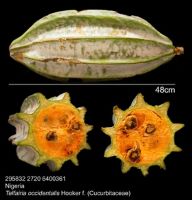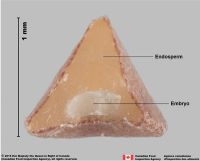Content is from Kirkbride et al. 2006Kirkbride et al. 2006:
Kirkbride JH, Jr, Gunn CR, and Dallwitz MJ. 2006. Family guide for fruits and seeds, vers. 1.0. Accessed September 2020-January 2022. URL: https://nt.ars-grin.gov/seedsfruits/keys/frsdfam/index.cfm ., without modification.
Updates are forthcoming.
Fruits: Pistil(s) compound; 1; 1-pistillate; with carpels united. Fruit anthocarpanthocarp:
simple or compound and including some tissue of non-ovarian origin (accessory tissue) , or pericarpium; simplesimple:
, or pericarpium; simplesimple:
fruit formed from a single flower with one pistil, solitary carpel or several fused carpels
; carceruluscarcerulus:
simple, multicarpellate, indehiscent fruit consisting of one or more seeds and air space enclosed by an undifferentiated pericarp (Spjut 1994)
; compound; sorosussorosis:
a multiple fruit composed of two or more fleshy fruitlets that developed on a peduncle
(Bdallophytum); without persistent central column; not within accessory organ(s); many-seeded; many to 1,000s; with 4–8-carpellate; with carpels united; with carpels remaining united at maturity; with carpels not radiating at maturity; with carpels remaining connected at stylestyle:
in a flower, the narrow and elongated part of the pistil between the stigma and the ovary; sometimes persisting in fruit ; without sterilesterile:
; without sterilesterile:
lacking male and/or female reproductive parts; also, not producing fruit or seed
 carpels; not sulcatesulcate:
carpels; not sulcatesulcate:
surface relief—having one or more elongate, relatively narrow and shallow depressions or grooves ; apexapex:
; apexapex:
the point farthest from the point of attachment, or the "tip" of an organ not beaked; wall fleshyfleshy:
not beaked; wall fleshyfleshy:
texture—fairly firm and dense, juicy or at least moist, and easily cut
; indehiscentindehiscent:
not opening on its own, as in a fruit
 , or dehiscentdehiscent:
, or dehiscentdehiscent:
(v. dehisce) splitting open at maturity to release contents (of a fruit) (or irregularly dehiscentdehiscent:
(or irregularly dehiscentdehiscent:
(v. dehisce) splitting open at maturity to release contents (of a fruit) ). Dehiscentdehiscent:
). Dehiscentdehiscent:
(v. dehisce) splitting open at maturity to release contents (of a fruit) and shedding seeds; without replumreplum:
and shedding seeds; without replumreplum:
the rim, formed by the persistent placentas, and connected by a false septum in Brassicaceae fruits. The fruit valves are attached to this rim and separate from it in dehiscent fruits.
. Epicarpepicarp:
outer layer of fruit wall or pericarp, if divided into layers; note here used synonymously with exocarp dulldull:
dulldull:
reflecting only a low proportion of incident light, with no apparent sheen ; durable; not glabrousglabrous:
; durable; not glabrousglabrous:
without hairs
(with hairs); hairs not glandularglandular:
surface relief—covered with small, raised secretory glands, regular or irregularly shaped, translucent or opaque, and maybe distinctly colored ; without armature; without wing(s); without apicalapical:
; without armature; without wing(s); without apicalapical:
at or pertaining to the end of the seed or fruit distal from its point of attachment (i.e., base)
respiratory hole. Mesocarpmesocarp:
the middle layer of the pericarp, if divided into layers present. Endocarpendocarp:
present. Endocarpendocarp:
the inner layer of the pericarp, if divided into layers absent. Funiculusfuniculus:
absent. Funiculusfuniculus:
(alt. funicle) stalk connecting the ovule (later seed) to the ovary (later fruit) placenta short; short without seed bearing hooks (retinacula); not persisting in fruit after seed shed.
short; short without seed bearing hooks (retinacula); not persisting in fruit after seed shed.
Seeds: Arilaril:
(broad sense) appendicular structure that wholly or partly envelops a seed and is produced from or a modification of the funicle, raphe, or outer integument; usually fleshy or pulpy, sometimes spongy or tufted-capillate, often brightly colored absent. Seed minute, or larger than minute; less than 1 mm long to 1 to less than 5 mm long; 0.5–1 mm long; ovateovate:
absent. Seed minute, or larger than minute; less than 1 mm long to 1 to less than 5 mm long; 0.5–1 mm long; ovateovate:
2D shape—egg-shaped in outline, widest point is towards one end of the organ, the other end tapers gradually, attachment at or near the broad end (compare obovate, ovoid) ; in transectiontransection:
; in transectiontransection:
a cross section; representing a plane made by cutting across an organ at a right angle to its length tereteterete:
tereteterete:
approximately circular in cross section; width and thickness approximately equal
 ; not bowl shaped; not nutlike; without winglike beakbeak:
; not bowl shaped; not nutlike; without winglike beakbeak:
a usually firm, terminal appendage, sometimes tapered ; without caudatecaudate:
; without caudatecaudate:
tapering to a long, tail-like appendage appendage(s); at maturity with food reserves; with endospermendosperm:
appendage(s); at maturity with food reserves; with endospermendosperm:
nutritive starch- and oil-containing tissue present in many seeds ; without canavanine. Sarcotestasarcotesta:
; without canavanine. Sarcotestasarcotesta:
pulpy or fleshy outer layer of the seed coat, simulates aril absent. Testatesta:
absent. Testatesta:
seed coat
 present, or absent (Cytinus, Raffesia); without embryo surrounded and capped by viscid tissue; without markedly different marginalmarginal:
present, or absent (Cytinus, Raffesia); without embryo surrounded and capped by viscid tissue; without markedly different marginalmarginal:
at, on, or close to the margin or border
tissue; without fleshyfleshy:
texture—fairly firm and dense, juicy or at least moist, and easily cut
or leatheryleathery:
texture—moderately thick, tough, and very pliable
layer over hard layer; tight; dulldull:
reflecting only a low proportion of incident light, with no apparent sheen ; surface unsmooth; surface with merged raised features; surface reticulatereticulate:
; surface unsmooth; surface with merged raised features; surface reticulatereticulate:
surface relief—netted, raised walls or concave grooves forming a net-like surface pattern with flat, concave, or convex interspaces ; without crease or line separating cotyledons from hypocotyl-radicle; without notch along margin where cotyledons from hypocotyl-radicle tip approach each other; without glands; without bristles; Cytinus, Raffesia glabrousglabrous:
; without crease or line separating cotyledons from hypocotyl-radicle; without notch along margin where cotyledons from hypocotyl-radicle tip approach each other; without glands; without bristles; Cytinus, Raffesia glabrousglabrous:
without hairs
, or pubescentpubescent:
surface relief—bearing hairs
; with hairs over surface; with short hairs; sparsely hairy; without agglutinated hairs; without glandularglandular:
surface relief—covered with small, raised secretory glands, regular or irregularly shaped, translucent or opaque, and maybe distinctly colored pubescence; without wings; without collar; without operculumoperculum:
pubescence; without wings; without collar; without operculumoperculum:
a dehiscent cap (or lid) of a seed or fruit that opens during germination or dehiscence
 ; colored; monochrome; brown (all shades); hard; not becoming mucilaginousmucilaginous:
; colored; monochrome; brown (all shades); hard; not becoming mucilaginousmucilaginous:
resembling mucilage; moist and sticky
when wetted; surrounding food reserve. Hilumhilum:
on seeds, the scar indicating where the funiculus was attached; on grass caryopses, the scar visible on the outer fruit surface revealing where the seed is attached on the inner fruit wall surface; or in Asteraceae cypselae, the scar visible on the outer fruit wall revealing where the fruit was attached to the receptacle punctate. Endospermendosperm:
punctate. Endospermendosperm:
nutritive starch- and oil-containing tissue present in many seeds development nuclear, or cellular (Cronquist); copious; smooth; without starch; with oils; without fatty acid containing cyclopropene; without apicalapical:
development nuclear, or cellular (Cronquist); copious; smooth; without starch; with oils; without fatty acid containing cyclopropene; without apicalapical:
at or pertaining to the end of the seed or fruit distal from its point of attachment (i.e., base)
lobes; without chlorophyll; without isodiametric faceted surface; without odor. Embryo differentiated from food reserve, or undifferentiated from food reserve; rudimentaryrudimentary:
(of embryo) embryo is small and fills less than a quarter of the seed and can be variable in shapes, such as linear, spatulate, or oval ; 1 per seed; partially filling testatesta:
; 1 per seed; partially filling testatesta:
seed coat
 (with food reserve); 0.1 times the length of food reserve (or less); at one end of seed not extending into a depression or cup; miniature; dwarf; without coleorhiza; without simmondsin; without stomata; not green; acotyledonous. Hypocotyl-radicle undeveloped.
(with food reserve); 0.1 times the length of food reserve (or less); at one end of seed not extending into a depression or cup; miniature; dwarf; without coleorhiza; without simmondsin; without stomata; not green; acotyledonous. Hypocotyl-radicle undeveloped.
General references: Corner, E.J.H. 1976. The seeds of Dicots, esp. vol. 2. Cambridge University Press, New York, Cronquist, A. 1981. An integrated system of classification of flowering plants, 1,262 p. Columbia University Press, New York, Goldberg, A. 1986 (dicots) & 1989 (monocots). Classification, evolution, and phylogeny of the familes of Dicotyledons. Smithsonian Contr. Bot. 58 for dicots (314 pp.) & 71 for monocots (74 pp.). [Goldberg's illustrations are reproduced from older publications and these should be consulted], Gunn, C.R., J.H. Wiersema, C.A. Ritchie, & J.H. Kirkbride, Jr. 1992 & amendments. Families and genera of Spermatophytes recognized by the Agricultural Research Service. Techn. Bull. U.S.D.A. 1796:1–500, Hooker, J.D. 1873 and forward. Icones Plantarum. William & Norgate, London. (plate number cited in text within [ ]), Mabberley, D.J. 1987. The plant-book, 706 p. Cambridge University Press, Cambridge, and Spjut, R.W. 1994. A systematic treatment of fruit types. Mem. New York Bot. Gard. 70:1–182.